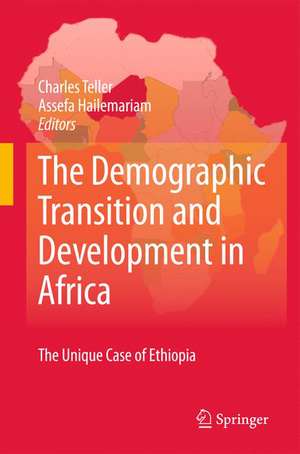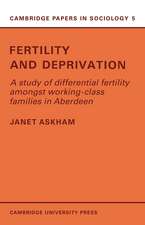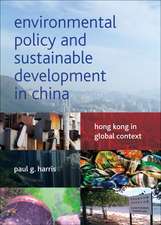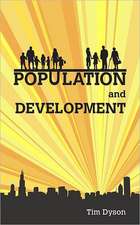The Demographic Transition and Development in Africa: The Unique Case of Ethiopia
Editat de Charles Teller, Assefa Hailemariamen Limba Engleză Hardback – 11 mar 2011
Preț: 651.51 lei
Preț vechi: 766.49 lei
-15% Nou
Puncte Express: 977
Preț estimativ în valută:
124.66€ • 130.51$ • 103.15£
124.66€ • 130.51$ • 103.15£
Carte tipărită la comandă
Livrare economică 07-21 aprilie
Preluare comenzi: 021 569.72.76
Specificații
ISBN-13: 9789048189175
ISBN-10: 9048189179
Pagini: 200
Ilustrații: XXIX, 359 p.
Dimensiuni: 155 x 235 x 38 mm
Greutate: 0.73 kg
Ediția:2011
Editura: SPRINGER NETHERLANDS
Colecția Springer
Locul publicării:Dordrecht, Netherlands
ISBN-10: 9048189179
Pagini: 200
Ilustrații: XXIX, 359 p.
Dimensiuni: 155 x 235 x 38 mm
Greutate: 0.73 kg
Ediția:2011
Editura: SPRINGER NETHERLANDS
Colecția Springer
Locul publicării:Dordrecht, Netherlands
Public țintă
ResearchCuprins
Preface: Dr. Bill Butz, CEO.- Population Reference Bureau.- Forword: Charles Teller and Assefa Hailemariam.- Acknowledgements: Charles Teller and Assefa Hailemariam.- I. Introduction: Context & Framework.- 1. The Complex Nexus Between Population Dynamics and Development in sub-Saharan Africa: A New Conceptual Framework of Demographic Response and Human Adaptation to Societal and Environmental Hazards: Charles Teller and Assefa Hailemariam.- II. Demographic Transitions and Human Development.- 2. The Fertility Transition in sub-Saharan Africa.- 1990-2005: How Unique is Ethiopia?: Tesfayi Gebreselassie.- 3. The Nature.- Pace and Determinants of the Incipient Fertility Transition in Ethiopia.- 1984-2007: Can the 4.0 TFR target for 2015 be met?: Charles Teller.- Assefa Hailemariam and Tesfayi Gebreselassie.- 4. Demographic transition and the development Nexus: real dividend or burden?: Yordanos Seifu.- Solomon Ayalu and Mihiret Habte.- 5. Better Educated Youth as a Vanguard of Social Change? Adolescent transitions to later marriage and lower fertility in Southwest Ethiopia: Moshi O. Herman.- Dennis Hogan.- Tefera Belachew.- Fasil Tessema.- Abebe Gebremariam.- David Lindstrom.- III. Health and Nutrition.- 6.Women’s Decision-making Autonomy and their Nutritional Status: A Socio-cultural Linking of Two MDGs: Yibeltal Tebekaw.- 7. Maternal Mortality and Human Development in Ethiopia: The Unacceptably Low Maternal Health Service Utilization and its Multiple Determinants: Munayie Seifu.- Mesganaw Fantahun.- Yirgu Gebrehiwot.- IV. Population Distribution.- Migration.- Urbanization and Labor Force.- 8. Migration and Urbanization: Addressing the Spatial Imbalance: Assefa Hailemariam and Aynalem Adugna.- 9. Rural-Urban Linkages in Ethiopia: Ensuring Rural Livelihoods and Development of Urban Centers; Aynalem Adugna and Assefa Hailemariam.- 10. The Importance of Permanent and Temporary Migration for Occupational Mobility in Urban Centers: YoungWomen are Doing Better than Young Men: Yambi Djamba & Charles Teller.- V. Vulnerability and Adaptation: Case Studies in Population-Resource Pressure and Food Insecurity.- 11. Urbanization and Changing Livelihoods: The Case of Farmers’ Displacement in the Expansion of Addis Ababa: Feyera Abdissa and Terefe Degefa.- 12. Malthusian or Bosrupian Consequences to Population Pressure and Food Insecurity? Vulnerability and Demographic Responses in 16 Drought-Prone Districts throughout Ethiopia: Charles H. Teller.- 13. Household Demographics.- Assets and Sustainable Rural Livelihoods: A Case Study from Rain-endowed South Western Ethiopia: Dula Etana.- VI. Development Policy and Program Evaluation.- 14. Population and Long-term Development Planning: Projecting an Unpredictable Future: Senait Tibebu.- 15. The National Population Policy (NPP) of Ethiopia: Achievements.- Challenges and Lessons learned.- 1993-2010: Assefa Hailemariam.- Solomon Alayu and Charles Teller.- 16.Barriers to Access and Effective Use of Demographic Data and Research for Development Policy in Ethiopia: Charles Teller.- Assefa Hailemariam and Negash Teklu.- VII. Conclusions and Policy Implications.- 17. Conclusions and Policy Implications: Charles Teller and Assefa Hailemariam.- Annexes: Index.- Author biographies.
Recenzii
From the reviews:
“This book is the first in the field of demographic transition and development in Africa with particular reference to Ethiopia … . This is a useful book that presents a number of important ideas and results. … The book is more important and useful to policymakers not only in Ethiopia, but for other countries in the sub-Saharan African region that might have similar demographic and socio-economic development issues.” (Gebremariam Woldemicael, Canadian Studies in Population, Vol. 40 (1-2), 2013)
“This book captures and brilliantly describes the distinctiveness of Ethiopian population health and nutrition trends, and the factors that impinge upon them. The authors creatively used existing data blended with a rich understanding of the local context to tell a complex story in a fascinating and insightful way. It is a must read for scholars and students of African demography.”
Dr. Jacob Adetunji, Government Demographer
“This book is clearly a masterful comprehensive exposition of the dynamics of interrelationships between population change and development in the Horn of Africa…. Full of illustrative insights and erudite discourse on key issues in the field of population science as they affect Ethiopia. … A must read for academicians, researchers and scholars in population field. This book is an authority and a reference point on Ethiopian demography”.
Clifford Odimegwu, Ph.D., Director, Programme in Demography and Population Studies, University of the Witwatersrand, South Africa.
“These leading scholars have brought together a collection of data and analyses of demographic information for Ethiopia that is worthy of careful study far beyond the borders of the country. This book will be of interest to those concerned about population trends and sustainability of the human experiment worldwide”.
William Ryerson, President of the Population MediaCenter
“This important book, the impressive result of a strong North-South partnership, asserts the uniqueness of Ethiopian demographics while also enriching our grasp of the traditional demographic transition theory”.
John F. May, Ph.D., Lead Population Specialist, The World Bank
“This work constitutes a timely and most relevant contribution to strengthening the knowledge base necessary for policy formulation and programme development in Ethiopia as well as other countries in Sub-Saharan Africa. Several of the findings and recommendations are valuable beyond the specific context of Ethiopia. Indeed, the diversity and deep contrasts in demographic, social, ecological and cultural contexts make Ethiopia’s case a particularly rich and interesting one. Demographic knowledge has much to contribute to policy formulation for sustainable development and this book is a good example of the relevance of such contributions”.
Dr. Rogelio Fernandez-Castilla, UNFPA/NY
“This book is the first in the field of demographic transition and development in Africa with particular reference to Ethiopia … . This is a useful book that presents a number of important ideas and results. … The book is more important and useful to policymakers not only in Ethiopia, but for other countries in the sub-Saharan African region that might have similar demographic and socio-economic development issues.” (Gebremariam Woldemicael, Canadian Studies in Population, Vol. 40 (1-2), 2013)
“This book captures and brilliantly describes the distinctiveness of Ethiopian population health and nutrition trends, and the factors that impinge upon them. The authors creatively used existing data blended with a rich understanding of the local context to tell a complex story in a fascinating and insightful way. It is a must read for scholars and students of African demography.”
Dr. Jacob Adetunji, Government Demographer
“This book is clearly a masterful comprehensive exposition of the dynamics of interrelationships between population change and development in the Horn of Africa…. Full of illustrative insights and erudite discourse on key issues in the field of population science as they affect Ethiopia. … A must read for academicians, researchers and scholars in population field. This book is an authority and a reference point on Ethiopian demography”.
Clifford Odimegwu, Ph.D., Director, Programme in Demography and Population Studies, University of the Witwatersrand, South Africa.
“These leading scholars have brought together a collection of data and analyses of demographic information for Ethiopia that is worthy of careful study far beyond the borders of the country. This book will be of interest to those concerned about population trends and sustainability of the human experiment worldwide”.
William Ryerson, President of the Population MediaCenter
“This important book, the impressive result of a strong North-South partnership, asserts the uniqueness of Ethiopian demographics while also enriching our grasp of the traditional demographic transition theory”.
John F. May, Ph.D., Lead Population Specialist, The World Bank
“This work constitutes a timely and most relevant contribution to strengthening the knowledge base necessary for policy formulation and programme development in Ethiopia as well as other countries in Sub-Saharan Africa. Several of the findings and recommendations are valuable beyond the specific context of Ethiopia. Indeed, the diversity and deep contrasts in demographic, social, ecological and cultural contexts make Ethiopia’s case a particularly rich and interesting one. Demographic knowledge has much to contribute to policy formulation for sustainable development and this book is a good example of the relevance of such contributions”.
Dr. Rogelio Fernandez-Castilla, UNFPA/NY
Textul de pe ultima copertă
Generalizations about the lack of demographic change and of progress in meeting the MDGs in sub-Saharan Africa are commonplace, but they are often misleading and belie the socio-cultural change. This book compares Ethiopia with other African countries, demonstrating the uniqueness of an African-type demographic transition: a mix of poverty-related negative factors with positive education, health and higher age-of-marriage trends that are pushing this population to accelerate the demographic transition and meet most of the MDGs. The book takes great care with challenges of inadequate data and weak analytical capacity to research this incipient transition, trying to unravel some complexities in Ethiopia: Slowly declining population growth rates with rapidly declining child mortality, very high chronic under-nutrition, low urban but high rural fertility; and high population-resource pressure along with rapidly growing small urban places.
Caracteristici
Transdisciplinary and contextual analysis of socio-economic development within context of vulnerability to poverty and food insecurity Case study of socio-economic, cultural and agro-ecological diversity within the volatile Horn of Africa Malthusian and Boserupian theories to help understand demographic constraints to development Africanized conceptual model of demographic responses and adaption to natural and human hazards and climate variability














